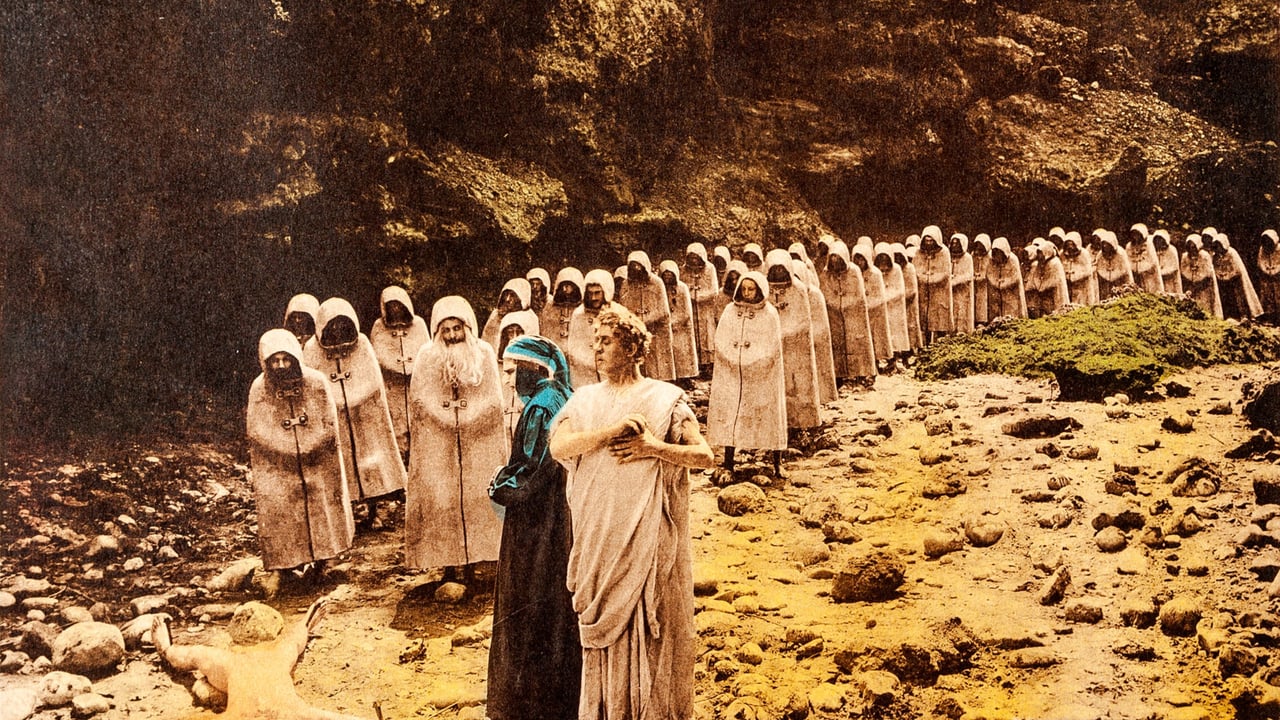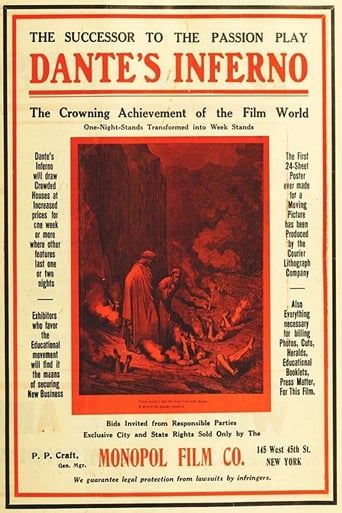

Yes, it's important as an very early feature film that actually survives in something like its original form (the loss of much of a film t like The Kelly Gang is a tragedy) but L'inferno is pretty primitive.The story telling technique consists of an inter-title telling us what we're about to see, followed by a static shot showing it to us. The acting is of the roll your eyes and wave your arms around variety the actor playing Peter of Vigna is so over the top it's an object lesson in overacting) and the actors playing Dante and Virgil are, to put it politely, pretty porky. There are some great images here - the river of filth, filled with the flatterers, a decapitated man, holding his screaming head up high in his hand - but there's quite a bit that's laughable too. Cerberus looks liked a rather friendly three headed alpaca, and the harpies look like something out of a school play. And then there's one of the most inappropriate soundtracks ever imposed on a poor innocent piece of celluloid. Tangerine Dream... really? So as a historical film artifact... worth the watch, but only with the sound down
... View MoreL'Inferno (1911) *** (out of 4) Historically important film as it stands as the first feature from Italy as well as the first film to show full frontal nudity. Dante travels to Hell where he gets to see what really goes on down there. The special effects and sets in this thing are downright beautiful and quite a sight to behold, which is the real reason to check this thing out. The pits of Hell look incredibly good and compared to what was being done in America at the time there's no question why this thing would go over well in this country. The only downside to the actual film is that it's visually rather bland. What Griffith was doing in America through editing would have certainly improved this film. Another gripe is that the DVD producer's added an electronic music score, which also features lyrics from some woman singer, which sound horrid and really doesn't add anything to the film. After the first few minutes I turned the soundtrack off and watched the film without any music. Hopefully a different version, with a new score, will be released someday.
... View MoreWell well well... This is a spectacle worth seeing. Filmed in 1910 and released early in 1911, it must have had a terrific impact on the viewer. It's full of special effects, flashbacks, monsters, appearances and disappearances, giants, dragons, demons and other hellish apparitions. There's a lot of nudity and agony, smoke and mud. But make no mistake: it's all according to 1911 standards. There still are no close-ups, no proper editing, and no acting to speak of aside from gestures as broad as one's hands are capable of doing. There's also no real story: it's a series of tableaux depicting Dante and Virgil moving through the different circles of Hell. It's all shot in broad daylight of course, in some weird looking mountains that can look quite majestic, but can also be no better than an disused Italian quarry. It's not boring, but it's very unclear what the viewer is supposed to think. There are lengthy title cards in very weird English, summarizing the action to come. Some of the trick photography is among the best that was available at that time (and men like Melies did a fantastic job even ten years before the release of this film); some is 'rags on a stick'-variety. Had there been at least a few close-ups, or anything to make it look more cinematic, I would have been much happier. The picture quality is so-so, it's obviously edited from two or three different prints that can vary quite a lot. It also could have been made more interesting using colour tinting for different hellish locations, such as red for fire and brimstone and blue for the ice lake. The music by Tangerine Dream became annoying very quickly. As long as it is ambiance background, it's OK, but as soon as the lady vocalist bursts into weird pseudo-Dantean songs, it's pure Hell indeed. I was seriously considering turning the sound down, but then I sort of grew used to it. This film might prove to be a bit heavy for those who are not prepared to sit through 1,5 hours of agonizing and slow moving journey that doesn't seem to lead nowhere. Then again, the selection of pre-WW I full length films released on DVD isn't wide enough to dismiss this one. But you need to know your Dante before you delve into this one, otherwise it's a total mishmash. A good friend and a bottle of strong booze would come handy as well.
... View MoreCasting an 8/10 for "L'Inferno" was perhaps the hardest vote I've cast so far on IMDb, and it wasn't because I doubted the film's quality. Considering it was made in 1911 for approximately $2 million and had to be rebuilt almost a century later, it's a fantastic exercise in early cinema. The footage is spectacular, and the primitive special effects still evoke the same shock and emotion they must have upon its premiere.My issue with the film is the soundtrack. Just as so many others on IMDb have noted, the Tangerine Dream music added to the DVD is terrible. Normally a bad soundtrack wouldn't be a problem, but with "L'Inferno" it's not optional. So, for my second viewing, I muted the television and played an old piece of classical music based on Dante's original epic. Needless to say, the second viewing was much better. Unfortunately, since there's no other version of "L'Inferno" to watch, I have to cast a bad vote for this film.
... View More